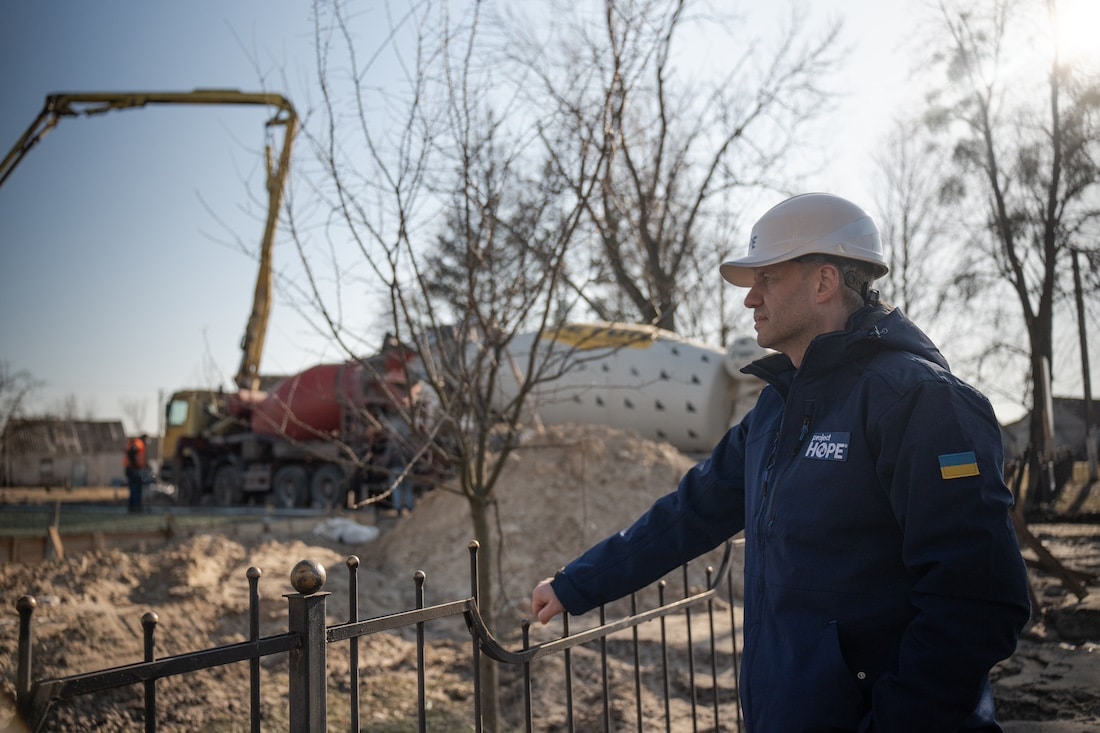On the Ground: What Resiliency Looks Like in Ukraine
Read a dispatch from Project HOPE’s director of media relations from the front lines of conflict in Ukraine.

Przemysl, Poland. This small border town has become a critical destination for those trying to enter and exit Ukraine after more than a year of active war has suspended air traffic altogether. It’s nearing midnight and hundreds of Ukrainians stand in a line, bundled in the cold and surrounded by luggage. They’re mostly women and young children with some older adults with canes and wheelchairs and walkers—the ones who are allowed to leave. They’re going home. Maybe just for a few days to see their husbands, fathers, or brothers or until the constant fear of shells, drones, and missile strikes sends them back west.
The Ukrainian rail system has operated as a constant and reliable means of deliverance, transporting millions of Ukrainians north or west in search of refuge and carrying life-saving humanitarian aid to war-torn communities in the south and east. Eleven hours later, I arrive in the train station in Kyiv as air sirens ring out around us. A fitting welcome to Ukraine.

Kyiv’s Sofia Square is full of broken, burnt tanks and military equipment, a sky-high tower of sandbags, and a wall covered in images of those lost in the war dating back to 2014, recently reimagined to fit images of thousands of new faces lost this past year. I’m haunted by the mix of beautiful smiles and resolute expressions, the flowers dotting the sidewalk beneath them and the empty spaces awaiting the other names and photos that will inevitably crowd its walls.
As you venture outside the city, signs of war are everywhere. Boarded-up windows, concrete barricades called hedgehogs, sidewalk concrete blasted apart, shelters covered in camouflage, a tower of burnt-out cars. In the forests and meadows dotting the roads, you catch an occasional glimpse of smoke where landmines lay in wait.
Project HOPE has seven offices across the country. And each of these regions bears the scars of conflict. Beyond Kyiv, there’s Lviv, which has transformed from a quieter hillside city in the north to a sanctuary for half a million internally displaced people. And to the east, there’s Dnipro where an apartment building was split in two by a missile that claimed the lives of nearly 50 civilians. There’s the artistic metropolis of Kharkiv, where missile attacks are constant, and the port city of Kherson, where Project HOPE and USAID’s water distributions sustain the local community who live just across the river from Russian snipers. In Odessa, on the Black Sea, blackouts are a daily occurrence. And in Kramatorsk, just 55 miles from Bakhmut, the battle rages day in and day out.
Bucha and Irpin feature street after street of decimated buildings and destruction. But between the devastation are glimmers of rebuilding: freshly painted gas stations and supermarkets, building materials and forklifts manned by droves of construction workers. It’s another sign of resiliency from the people who survived everything from Russian occupation to war atrocities in their typically-quiet, middle-class residential streets.

In the year Project HOPE has been responding here, we’ve learned how critical it is to rebuild. Not just for morale, but to reconstruct a health system that can sustain the population. We visit the site of an ambulatory clinic, which we’re building from scratch to provide the local community with critical medical services that had been interrupted or lost altogether.

Then on to a destroyed kindergarten encircled by the fading primary colors of playground equipment covered in overgrowth. The surrounding buildings are terrifying examples of war—blown open to expose the kitchen tables and bookshelves of the families that once called them home. It’s not a health facility, but we understand how critical it is to recreate safe spaces for our children, so we’ve committed to rebuilding this, too.

As towns were liberated across the east, Project HOPE expanded with mobile medical units (MMUs) that have provided regular check-ups for communities that went months without. This tiny location sees about 1,000 patients a month, and the director celebrates the arrival of the Project HOPE-donated generator and the medications that act as lifelines for her patients.

In Zaporizhzhia, we run a center for internally displaced people (IDPs) just 30 minutes away from the front lines. Kids crowd around a table full of arts and crafts as a social worker supervises. While the kids play, the parents gather in the next room for therapy sessions. The one good thing that has come out of all this, the psychologist says, is that Ukrainians are starting to finally recognize the importance of mental health. And each day more people come, warming up to the idea of building a community and refuge here.
I hold back tears at the mention of a woman who is processing the loss of her mother who committed suicide while living under Russian occupation without her daughter and granddaughter. This is just one story of so many that will break your heart—reminders of how critical Project HOPE’s mental health support has been and will continue to be, for months and years to come.
Despite everything, the country is brimming with a deep sense of resiliency that feels infectious. Even as another sleeper train whisked me west to safety outside Ukraine’s borders, I found myself unable to stop checking the alerts, thinking of my remarkably inspiring 89 Ukrainian colleagues who stayed behind to serve their communities.
A week in Ukraine reminded me why we do this work: because we have no other choice.
Courtney Ridgway is Director of Media Relations at Project HOPE.







